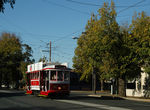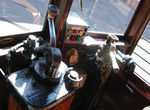Bendigo, Australia
![]()
Bendigo Tramways cars 15 (outbound) and 19 pass inbound at McCrae and Rayne Streets. Photo by Peter Ehrlich.
Overview
Bendigo, the central city in the Goldfields region of the State of Victoria, is located approximately 160 kilometers northwest of Melbourne. Founded in 1851, the tramway came to Bendigo circa 1890, first in the form of battery-powered trams on a line between Bendigo (then called Sandhurst) and Eaglehawk, which weren't successful and were replaced by steam trams in 1892, after an 18-month hiatus. Electrification arrived on April 8, 1903 and ultimately there were four routes radiating from Charing Cross, the center of town; east along Mitchell Street; south to Golden Square; and north along Pall Mall and McCrae Street (today's surviving route) to Lake Weerona, later reaching the Gasworks and North Bendigo; and west along the already-built tramway to Eaglehawk. A new carbarn and powerhouse was built along the north line at Arnold Street (now Tramways Avenue), which is still in use today. 10-minute rush hour and 15-minute base service was provided. The operating company was the Electric Supply Company
In 1931 the State Electricity Commission of Victoria took over the tramways operating in Bendigo, Ballarat and Geelong, albeit reluctantly. Inheriting a severely rundown, 30-year-old tram fleet and infrastructure, SECV set out to modernize all three systems, a process started by its predecessors with purchase of a number of 4-wheel Birney cars from J. G. Brill of Philadelphia (which went to Geelong) and a large group of California-style streetcars made redundant in Melbourne. After World War II, more ex-Melbourne trams, these being double-truck versions, arrived, as did the Geelong Birneys, completing disposal of the original single-truck Bendigo fleet. Service continued at high levels throughout the Fifties and Sixties, but the SECV, citing substantial losses, phased out trams in Geelong by 1956 followed by the Ballarat abandonment on Sept. 19, 1971. In Bendigo, the final trams operated into the evening of April 16, 1972.
But even before the cessation of service, the Bendigo Trust was formed. This organization was created to preserve Bendigo's heritage, notably the Central Deborah Mine and the tramway. The Trust was successful in its negotiations with SECV for keeping the entire North Line, the carbarn, and a portion of the Golden Square line as far as Myrtle Street and the mine. In addition, all 23 trams on the property at time of abandonment were retained. On December 9, 1972, the first trams operating under the auspices of the Bendigo Trust took to the streets of Bendigo, cheered on by the populace. Over the past 30+ years, much restoration has been performed on the fleet, and service now operates 7 days a week (initially, the trams ran weekends and holidays only). The trolleys have been transformed into "Talking Trams", with an on-board recording pointing out historic buildings, sites and historical anecdotes of Bendigo's history. In addition, some examples of trams from Melbourne and other locales have been acquired and placed in service, supplementing the original Bendigo fleet. The crews who operate and maintain the trams are both paid staff members and volunteers.
Trams run hourly on most days, half-hourly on summer days and more frequently during special events. Trams alternate trips; usually three different trolleys are in use on any given day. The normal route is for trams to pull out and turn north, operating to the Nth Bendigo terminal. Then the tram will run south along Weerona Avenue and Nolan Street, McCrae Street and Pall Mall to Myrtle Street and the Central Deborah Mine, then back to Tramway Avenue and the barn. A fresh crew will take the next tram out on the line. Riders can visit and tour the carbarn and gift shop between runs.
In addition to the historic carbarn, the Trust has a storage yard at the old Gasworks, near the Nth Bendigo terminal. About 15 or so trams are stored here awaiting restoration or overhaul.
A visit and ride on the Bendigo trams is well worth your while, and, combined with the operation in nearby Ballarat, makes for a pleasant weekend trip away from the tram capital of the Southern Hemisphere, Melbourne.
Roster
Some of the trams seen in the images contained on these pages:
Bendigo 5: Built 1913 for Prahran & Malvern Tramway Trust, Melbourne; inherited by the Melbourne & Metropolitan Tramways Board (M&MTB). Sold to Geelong in 1948, transferred to Bendigo in 1956 after closure in Geelong. Available for charters only.
Birney 15: Built 1923 by J. G. Brill of Philadelphia, PA for Geelong. Transferred to Bendigo in 1948. In service.
California Type 19: 4-wheel tram built 1917 (delivered 1918) for Hawthorn Tramway Trust, Melbourne; inherited by M&MTB. Transferred to Bendigo in 1935. One of the first four "Talking Trams". In service.
Birney 30: Built 1925 by Brill for Port Adelaide. Transferred to Geelong in 1936 and to Bendigo in 1948. One of the first four "Talking Trams". In service.
Melbourne 31: Built 1927 by M&MTB Preston Workshops as W1 421, converted to W2 configuration in 1936. Acquired by Bendigo Trust in 1985, reconverted to W1 in 2000. In service.
Melbourne 35: Originally M&MTB 470; same history as #31, except acquired in 1988. In service.
Bendigo 36: Built 1937 by M&MTB Preston Workshops as W5 808, converted to SW5 in 1986. Acquired by Bendigo Trust in 1991; repainted as Bendigo 36 in SECV livery. In service.
Melbourne 44: Built 1914 by Duncan & Fraser, Adelaide, for Prahran & Malvern Tramway Trust; inherited by M&MTB. Sold to Bendigo in 1951 and renumbered 17; restored as PMTT 44 in 1981. Needs repaint and wheel work, otherwise operable.
Ballarat 45: Built 1914 by Duncan & Fraser for PMTT; inherited by M&MTB. Sold to Bendigo in 1951 and renumbered 18. Leased to Ballarat 2001-2005 for that city's Golden Jubilee, painted gold and renumbered 45. Will be restored as Bendigo 18. Operable, but not used.
Melbourne 74: Built 1977 by COMENG, Melbourne, for Melbourne, class Z1. Retired 2002; acquired by Bendigo Trust in 2002. Operable, but not yet certified for service.
Melbourne 138: Built 1918 by Duncan & Fraser for Hawthorn Tramway Trust as #32; became Melbourne P class 138 after M&MTB takeover. Sold to Bendigo in 1945 and renumbered 24; being restored as Melbourne 138.
Melbourne 466: 4-wheel tram built 1928 by M&MTB Preston Workshops as X1 class; retired 1962. Restored by Bendigo Trust in 2004. Operable.
Melbourne 880: Built between 1939 and 1951 by M&MTB Preston Workshops as W6 class, later SW6 class. Acquired by Bendigo Trust in 2005. Stored, awaiting restoration.
Photo Gallery
| Five Random Images | ||||
 Image 40967 (187k, 720x478) Photo by: Peter Ehrlich Location: McCrae/Tramways Avenue |  Image 40977 (152k, 720x478) Photo by: Peter Ehrlich Location: Bendigo Depot |  Image 40983 (145k, 720x478) Photo by: Peter Ehrlich |  Image 40990 (166k, 720x478) Photo by: Peter Ehrlich Location: Bendigo Depot |  Image 50541 (248k, 1024x795) Photo by: Herman R. Silbiger Location: Bendigo Depot |
Links
Official Site - Bendigo Tramways. The official site of the Bendigo Tramway, including history, schedules, fares, and more.
Page Credits
By Peter Ehrlich.